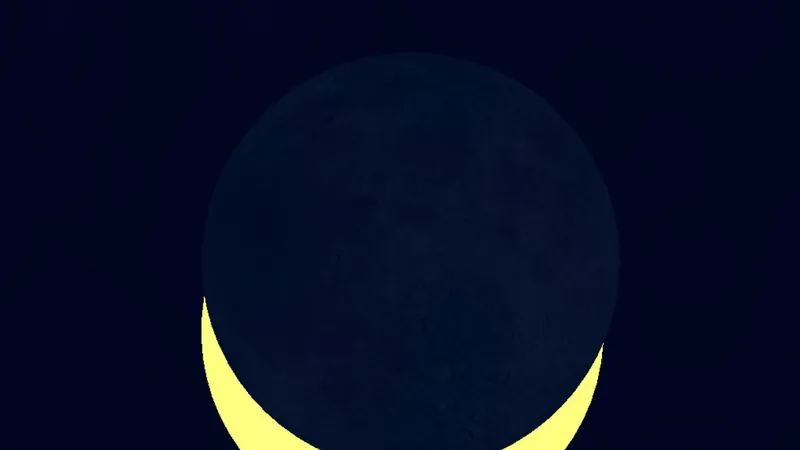
Don't Miss the Rare 'Solar Horns' During the Partial Solar Eclipse on March 29 — Explore 6 Prime Viewing Spots in the US and Canada!
2025-03-24
Author: Siti
On March 29, 2025, a rare astronomical event will unfold for North American stargazers.
If you're in the right place with clear skies, you'll have the extraordinary chance to witness the captivating phenomenon known as "solar horns." This occurs when the cusps of a crescent sun during a partial solar eclipse appear as two distinct points on the horizon, creating a stunning visual effect during sunrise.
Optimal Locations for Viewing 'Solar Horns'
To make the most of this celestial spectacle, choosing the right viewing location is essential, especially for those in the northeastern U.S. and eastern Canada. The "solar horns" will be best observed in specific areas stretching from southeastern Quebec and southwest New Brunswick in Canada to northern Maine in the U.S., particularly within the region between the St. Lawrence River estuary and the Bay of Fundy.
For the best experience, seekers need an unobstructed view of the eastern horizon. Coastal spots and elevated terrains work perfectly, but even lower land can offer a thrilling vantage point when viewed from higher elevations. Utilizing resources such as Xavier Jubier's interactive Google Map, The Photographer’s Ephemeris, and Timeanddate.com can help eclipse enthusiasts find the best locations. Also, it’s wise to carry a compass for precise navigation once you arrive at your chosen spot.
Top 6 Viewing Spots for Solar Horns:
1. **Forestville, Quebec, Canada** - **Sunrise:** 6:20 a.m. EDT at 83.7 degrees ENE. - **Maximum Eclipse:** 87% at 6:24 a.m. EDT. - **Best Viewing:** From the coastline, thanks to its clear water horizon.
2. **Saint Andrews, New Brunswick, Canada** - **Sunrise:** 7:15 a.m. ADT at 84.2 degrees ENE. - **Maximum Eclipse:** 83% at 7:18 a.m. ADT. - **Best Viewing:** Pagan Point Nature Reserve provides an ideal low horizon over Passamaquoddy Bay.
3. **Quoddy Head State Park, Maine, U.S.** - **Sunrise:** 6:13 a.m. EDT at 84.2 degrees ENE. - **Maximum Eclipse:** 83% at 6:17 a.m. EDT. - **Best Viewing:** From West Quoddy Head Lighthouse, overlooking the bay for maximum visibility.
4. **South Lubec Flats, Maine, U.S.** - **Sunrise:** 6:13 a.m. EDT at 84.2 degrees ENE. - **Maximum Eclipse:** 83% at 6:18 a.m. EDT. - **Best Viewing:** An oceanfront spot that dazzles with the rising eclipsed sun between Campobello Island and Quoddy Head.
5. **Campobello Island, New Brunswick, Canada** - **Sunrise:** 7:14 a.m. ADT at 84.2 degrees ENE. - **Maximum Eclipse:** 83% at 7:18 a.m. ADT. - **Best Viewing:** Liberty Point offers a magnificent ocean horizon view over the Bay of Fundy.
6. **Presque Isle, Maine, U.S.** - **Sunrise:** 6:16 a.m. EDT at 84 degrees ENE. - **Maximum Eclipse:** 85% at 6:21 a.m. EDT. - **Best Viewing:** Inland, but an elevated spot is recommended for optimal viewing of the low horizon.
How to See the Eclipsed Sunrise
While the "solar horns" phenomenon is unique to the locations mentioned, anyone along the U.S. east coast—from Maine to Cape Cod—can catch a glimpse of an eclipsed crescent sunrise. Various places, including New York, Pennsylvania, Maryland, Washington D.C., and Virginia, will experience a very slight eclipse at sunrise, given a clear view to the northeast.
Safety First!
Always remember: **NEVER look directly at the sun without proper eye protection**! Regular sunglasses are not sufficient, as they do not filter out harmful ultraviolet (UV) and infrared (IR) rays capable of damaging your eyesight. Utilize specially designed solar filters and eclipse glasses when observing the sun to ensure a safe and enjoyable viewing experience.
Mark your calendars for March 29, 2025, and prepare for a breathtaking celestial display that you won’t want to miss!



 Brasil (PT)
Brasil (PT)
 Canada (EN)
Canada (EN)
 Chile (ES)
Chile (ES)
 Česko (CS)
Česko (CS)
 대한민국 (KO)
대한민국 (KO)
 España (ES)
España (ES)
 France (FR)
France (FR)
 Hong Kong (EN)
Hong Kong (EN)
 Italia (IT)
Italia (IT)
 日本 (JA)
日本 (JA)
 Magyarország (HU)
Magyarország (HU)
 Norge (NO)
Norge (NO)
 Polska (PL)
Polska (PL)
 Schweiz (DE)
Schweiz (DE)
 Singapore (EN)
Singapore (EN)
 Sverige (SV)
Sverige (SV)
 Suomi (FI)
Suomi (FI)
 Türkiye (TR)
Türkiye (TR)
 الإمارات العربية المتحدة (AR)
الإمارات العربية المتحدة (AR)